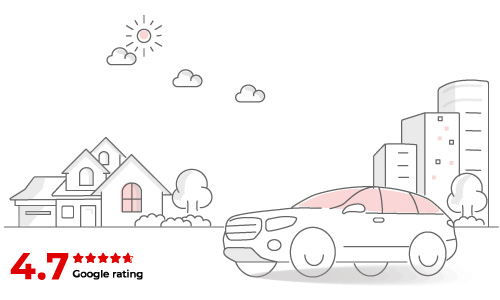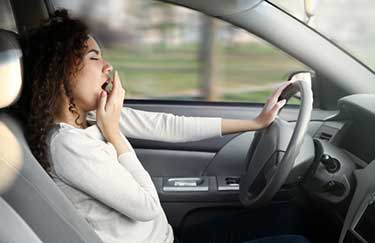
Written by Kayla Jane Barrie Updated on Feb 26, 2025 6 mins read

Many of us are guilty of drowsy driving. We’re tired after a long day at work. We drive home late at night after a busy day. Some of you may even drive for a living. People don’t take driving while drowsy as seriously as impaired or distracted driving.
It’s estimated that 50% of drivers have gotten behind the wheel when feeling drowsy. It is reported that 20% of people have fallen asleep at the wheel. Of that, 1 in 25 drivers say that they have fallen asleep behind the wheel in the last month. The fact is that drowsy driving can be just as dangerous as impaired driving or texting and driving.Here we take a look at this important driving safety topic and outline the dangers of drowsy driving, laws, facts, methods for prevention and how it can impact car insurance costs.
Drowsy driving, also referred to as tired driving or fatigued driving, is the operation of a vehicle when you are too tired to remain alert behind the wheel. Driving while tired impacts your ability to focus impairs your decision-making, and can impact your ability to react.
It is estimated that approximately 20% of fatal collisions in Canada involve driver fatigue. That’s 1 in 5 collisions. Many other non-fatal collisions involve drivers who exhibit the signs of drowsy driving.
Driving while tired impacts your ability to drive. Even though driving tired is responsible for a significant amount of accidents, it does not receive as much attention as impaired driving in Ontario.
Here are some reasons why driving while fatigued is dangerous because :
There are severe consequences for driving tired, but is it illegal?
There are currently no specific laws related to driving while tired in Canada. However, the impact of driving while tired can cause you to take actions on the road that are punishable by law.
Even though the dangers are well documented, it is not against the law to drive while tired. However, it is strongly discouraged. The government has invested in legislative acts and awareness campaigns in an attempt to educate drivers about the dangers of fatigued driving.

Drivers don’t think twice about feeling extremely tired while driving. They press on instead of taking a break on long drives, and many drive when they should be resting.
Since there is no test for drowsy driving, it can be difficult to know when you are too tired to drive. But there are warning signs to indicate when you should consider taking a break or not driving.
Here are the common warning signs that you may be too tired to drive :
According to a Canadian Association of Chiefs of Police report, 20% of fatal collisions are caused by drowsy drivers. Here are some of the effects of drowsy driving on your ability to drive :
If you experience any of these signs, consider taking a break, switching drivers, or getting some sleep before driving.
There are various reasons and specific groups of driving who are more prone to driving tired.
Here are the types of drivers who are at higher risk than others :
Just how dangerous is drowsy driving? Many experts suggest driving while tired can have the same or similar impairment effect as alcohol.
According to the National Sleep Foundation :
“Drowsy driving is dangerous because sleep deprivation can have similar effects on your body as drinking alcohol. Being awake for 18 hours straight makes you drive like you have a blood-alcohol level of .05 (for reference, .08 is considered drunk). If you’ve been awake for a full 24 hours and drive—say, after a night where you just couldn’t fall asleep—it’s like you have a blood-alcohol level of .10.”
Both types of impairment make it difficult for drivers to focus on driving and negatively impact the speed and accuracy of a driver’s decision-making capabilities.
Not convinced driving while tired is a serious road safety issue? Check out these drowsy driving stats and facts :
Feeling tired while driving happens. Here are some things you can do to stay safe and focused :
People will try almost anything to stay awake while driving. Rather than stopping and taking a break, they will try other ineffective tactics. The following do NOT work to keep you awake when driving :
Being proactive is the key to avoiding driving while fatigued. These steps can help ensure you are alert and ready to drive. Here are some tips to prevent driving tired :
You play a key role in keeping our roads safe. If you feel the effects of drowsy driving, pull over and take a break.
If you are a commercial driver or work in the transportation industry, you may be interested in the North American Fatigue Management Program (NAFM). This tool was launched in 2013 to help carriers develop fatigue management programs. Their goal is to enhance a carrier’s ability to effectively deal with the challenges of fatigue in a highly competitive, widely dispersed, and rapidly changing industry.
This free resource consists of ten learning modules covering a range of topics, including :
You may get tired when driving if you have specific medication, shift work, alcohol, not having a good sleep or because of an untreated sleep disorder
It is not illegal to drive drowsy. There is no testing tool to assess a driver’s level of tiredness. But there are still repercussions such as accidents which can lead to increased car insurance quotes.
Around 20% of Canadians admit to falling asleep behind the wheel, at least once in the year. Drowsy driving contributes to 21% of automobile accidents every year.
Fatigue driving is when the driver, after prolonged periods of continuous driving, experiences mental and physical malfunctions. If you don’t have a good sleep at night, even a short period of driving can still cause fatigue.
| Categories | Auto |
|---|---|
| Tags | Auto Coverage |
Read our insurance blog to get helpful tips, information and news.
Drive safe this winter! Check out these tips for driving in snowy and icy conditions in Ontario. Get other helpful info and FAQs on winter driving.
Drive safer this winter. Learn how the right set of winter tires drastically reduces stopping distance and risk on ice and snow. Get expert tips from your trusted insurance provider.
Ontario municipalities have until November 14 to remove all automated speed enforcement cameras following fast-tracked provincial legislation. This post breaks down why the government is removing them, the pushback from road safety advocates, and what alternative measures will replace them.
What is specified perils insurance coverage? Learn about named perils policies for Ontario drivers. Get info about coverage, if you need it & answers to common questions.